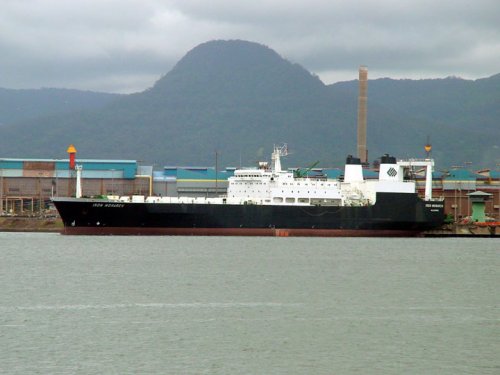In a story called 'The Last War' by Jan Nienmczyk
http://www.tboverse.us/HPCAFORUM/phpBB3/viewtopic.php?f=28&t=1914&st=0&sk=t&sd=a
He mentions a 1988 proposal to turn two flat steel product ships into CVE for the RAN, this never happened due to opposition from the CNS but does anyone have any drawings for this?
2 BHP Iron Duke class flat steel product carriers laid up late 1980s. After initial rejection by RAN CNS 1988 as offered by BHP for $36 million in tax credits, ordered purchased by government to maintain ASW helicopters at sea, 1991 at cost $72 million. Converted to operate up to six Seaking Mk50A ASW helicopters with dipping sonar, or like number utility helicopters. However, able to accommodate up to 10 Seaking in hangar deck. One acft lift. No ability to accommodate troops.
Mark Bailey mentions the proposal elsewhere
We tried the cheap-and-nasty approach in ‘82. BHP had two flat steel products carriers (Iron Monarch and iron Duke) laid up in Sydney. They would have made excellent and economical helicopter carriers, and their engines were civilian versions of the LM2500 naval gas turbine in the Perry’s (85% commonality IIRC). 8 Seaking (our A/S helo back in those days) could have been carried in their hangar, the converted cargo deck. Everyone said it was a good idea, and it cost nowt, because BHP wanted to gift them to the Commonwealth in return for a tax write-off. Admiral Mike Hudson said no, he did not want the flagship of the RAN to be a converted merchant ship. The troops did not nickname him ‘Mudguard’ for nothing (Mudguard = shiny on top, *** underneath)
MarkL
Canberra
http://www.tboverse.us/HPCAFORUM/phpBB3/viewtopic.php?f=28&t=1914&st=0&sk=t&sd=a
He mentions a 1988 proposal to turn two flat steel product ships into CVE for the RAN, this never happened due to opposition from the CNS but does anyone have any drawings for this?
2 BHP Iron Duke class flat steel product carriers laid up late 1980s. After initial rejection by RAN CNS 1988 as offered by BHP for $36 million in tax credits, ordered purchased by government to maintain ASW helicopters at sea, 1991 at cost $72 million. Converted to operate up to six Seaking Mk50A ASW helicopters with dipping sonar, or like number utility helicopters. However, able to accommodate up to 10 Seaking in hangar deck. One acft lift. No ability to accommodate troops.
Mark Bailey mentions the proposal elsewhere
We tried the cheap-and-nasty approach in ‘82. BHP had two flat steel products carriers (Iron Monarch and iron Duke) laid up in Sydney. They would have made excellent and economical helicopter carriers, and their engines were civilian versions of the LM2500 naval gas turbine in the Perry’s (85% commonality IIRC). 8 Seaking (our A/S helo back in those days) could have been carried in their hangar, the converted cargo deck. Everyone said it was a good idea, and it cost nowt, because BHP wanted to gift them to the Commonwealth in return for a tax write-off. Admiral Mike Hudson said no, he did not want the flagship of the RAN to be a converted merchant ship. The troops did not nickname him ‘Mudguard’ for nothing (Mudguard = shiny on top, *** underneath)
MarkL
Canberra

